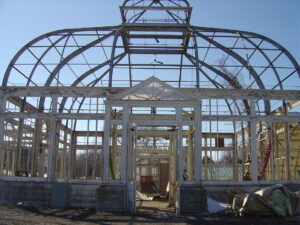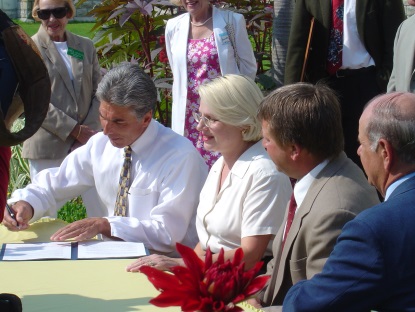That same year, the Society’s Board of Directors hired a professional staff to oversee operations, horticulture, marketing and educational programs. A formal volunteer program was also established as the Society depended heavily upon the commitment and knowledge of an ever growing group of volunteers. A comprehensive master plan was also put in place as a road map for the future.
2005 was a year of re-inventing. An admission fee was charged to the public for the first time as a way to help the Society become self-sustaining. The admission fee also required a major renovation to include space for an admission desk and a gift shop. Additional renovations included expanded restrooms for visitors and hardscape walkways leading up to the front entrance. The main palm dome was reconfigured, the horticulture collection within was replaced and a new automatic, thermostatically controlled misting system was installed. This system was designed to keep the plants healthy and help to make their care more efficient. The misting system was also installed in greenhouse 2 and 3.

Greenhouses 11 and 12 were completely renovated and restored between 2005 and 2007 as outlined in the master plan. In 2007 the Outdoor Children’s Garden was constructed and opened to the public. The Society and Erie County constructed an administration building, two state-of-the-art greenhouses and a visitor parking lot in 2011.
A comprehensive strategic plan was created in 2011 to span the following three years. The strategic intent of the plan is for the Botanical Gardens to take its rightful place as an essential community cultural institution — the horticultural hub of Western New York, perceived by all as the primary reference center for everything botanical. Through a broad array of attractions, programs and services, we will be relevant to the interests and lives of an ever-expanding audience.
In 2012, the indoor Wegmans Family Garden was constructed and the outdoor Children’s Garden was renovated. In 2013, the horticulture exhibit in greenhouse 11 underwent a major renovation and a Native Garden and gazebo were added to the outdoor grounds. By the end of 2013, dozens of community collaborations had been established and exciting new programing emerged.
Between 2015 and 2016, greenhouses 2 and 3 were completely restored by Erie County. In January 2017, The Society installed and opened two new exhibits, the Aquatic Garden and the Asian Rainforest, inside the renovated greenhouses. With the help of generous donors and members, the Society raised the funds to create and install the new exhibits. Projects like these ensure the Botanical Gardens will thrive for generations to come.
With a dedicated family of employees, over 250 active volunteers and a dynamic board of directors, the Buffalo and Erie County Botanical Gardens Society is thriving! Today, over 140,000 people annually visit the Botanical Gardens to enjoy the amazing architecture and the indoor and outdoor garden sanctuaries. It is a gathering place where visitors can find peace and harmony and enjoy the simple power of the natural world. Some visitors also see it as a place for spiritual healing, meditation and reflection.
The historic Buffalo and Erie County Botanical Gardens is a living museum that inspires curiosity and connects people to the natural world. It is a premier cultural destination that engages visitors through a distinct and unique plant collection.










